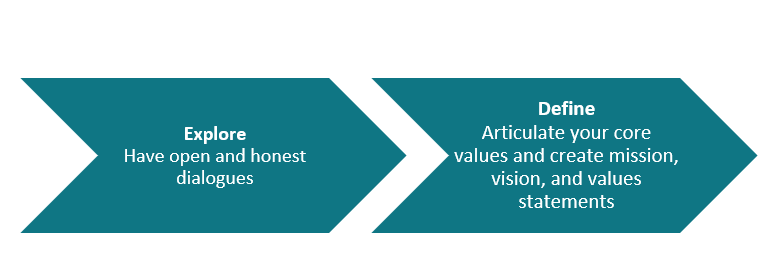Takeaways Blog on Defining and Translating Motivations and Values

Courtesy of Mododeolhar on Pexels
Defining motivations and values is in many ways the most critical step a family takes as they chart a path forward in their philanthropy. Understanding the reasons why families give and the values that connect them together will help guide families through their philanthropic effort. Motivations and values not only give families a common purpose, but also inform their approaches to strategy, operations, governance, and much more. In NCFP’s recent webinar, President and CEO Nick Tedesco discussed what motivations and values are in the context of family philanthropy, why identifying motivations and values is an essential part of the family giving lifecycle, and how to explore and operationalize motivations and values across a giving effort. Here are four important takeaways from the discussion:
1. Motivations and values are at the core of every family philanthropy effort.
Motivations and values guide both what a family funds and how they approach their giving. It’s a framework for making decisions, and an essential tool that fundamentally guides grantmaking, governance and operations. Families also use motivations and values as a measure of success and accountability—it’s a way to ask if philanthropic goals are in alignment with your shared purpose.
So what do we mean when we talk about motivations and values in philanthropy? Motivation is the inspiration and rationale behind why donors give. It’s the core of why one commits to philanthropy. Motivations give language to the fact that philanthropy is a deliberate and conscious choice. As a wealth holder, you can choose to spend the wealth in a number of ways. Yet as a donor, you’ve fundamentally chosen to be philanthropic—you are motivated to use your resources for the public good.
Successful philanthropic efforts are not only based on motivations, but also the values that are important to you and your family. When we talk about values, we mean the core principles, characteristics and behaviors that underlie all decisions and actions. Values span a broad range of ethical, spiritual and political tenets that guide decisions, and each and every family will find different values that speak to the meaning behind their work.
Values give families a common purpose and direction. They guide the family in all aspects of their philanthropy from governance, operations and grant-making. And a clear understanding of your values can help you focus on causes and organizations that are aligned with your mission.
2. Families are motivated to give for many reasons, and these motivations affect how they approach giving.
For many families, there’s a natural evolution in the lifecycle of philanthropy. Giving styles most often begin as unstructured, opportunistic and relational, and evolve into more formal structured and intentional approaches over time. It’s important to stress that these motivations are not mutually exclusive, and no single approach is correct.
In general, motivations stem from a number of drivers deeply related to values:
- Social connections and relationships: Many donors approach their giving with a relational mindset. It’s not uncommon for a donor to support a cause or organization because of a friend or a network.
- Immediate needs and opportunities: Opportunistic giving often expresses itself through the support of immediate and urgent needs.
- Family unity and legacy: For many, philanthropy is an opportunity to build a family legacy, to come together around common traditions and values, and to keep the family together.
- Issues or communities: Donors are often compelled to support an issue or community that holds meaning to them or represents an opportunity to advance enduring social change.
- Privilege: Many donors recognize their privilege, their success and good fortune, and the recognition of this privilege leads many to want to be altruistic, make a difference and pay it forward to others.
- Impact: Donors motivated by impact are driven by a desire to advance social change and are likely to use formalized intentional philanthropy to leverage the power of philanthropic capital to either close the gap or catalyze innovation.
3. Families must explore and define their values.
There are two steps in the process of identifying your motivations and values. The first is to explore. Families must engage in an open and honest dialogue. Ask questions about purpose, reflect on the role of stewardship, and identify the goals and objectives. These conversations will likely address two core questions: Why do you choose to do this work, and what do you want to see out of your effort? These questions must be considered within two contexts—social impact or the external, and family unity and the internal. Over time, the family will need to find approaches that meet both sets of goals and bring them both together.
The second step is to define and articulate. This is when families synthesize earlier conversations into guiding principles that take the form of mission, vision and value statements. These statements are iterative in nature. They should be revisited, updated and may evolve over generations.

4. These concepts are not static—they are ever-evolving.
Families often leap to the active grant-making itself and neglect the formative discussions of why they chose to give and what they want to see reflected in their philanthropy. Time and time again, we’ve seen families stumble when they skip this crucial step. They often struggle to work together to make decisions and to build efforts under a common purpose.
Families often define and revisit their motivations and values at various times. For those just beginning, the process of defining motivations and values helps individual family members, as well as the collective, understand what’s important to them, and how they’ll model their approach. For more established philanthropic families, it’s important to revisit motivations and values over time, as the family and external circumstances evolve. Ideally these discussions take place at the beginning of a family philanthropy’s effort, but they can and should be incorporated throughout the lifetime of the effort.
For more resources, visit NCFP’s Values and Motivations Content Collection. The recording and transcript of “Defining and Translating Motivations and Values” are available exclusively for NCFP Friends of the Family and Partner Subscribers.
